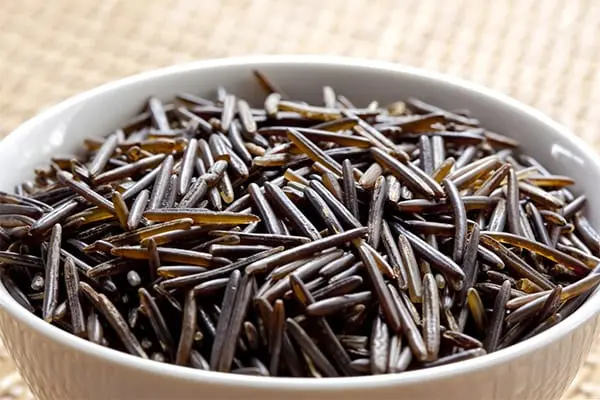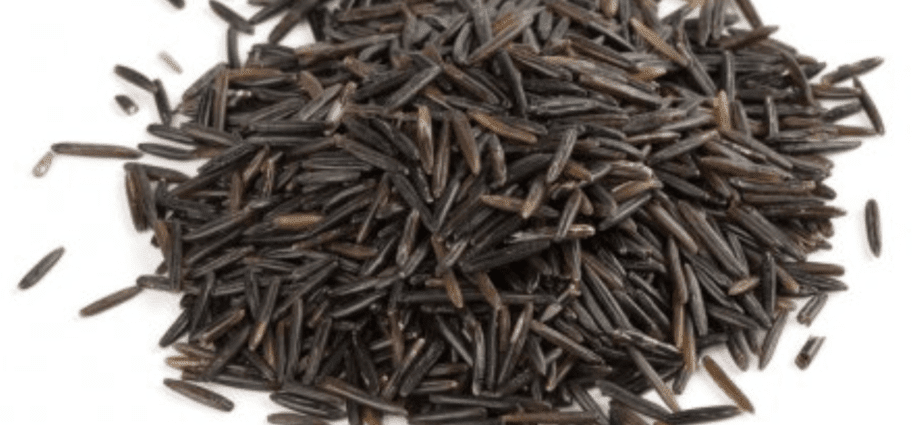Contents
Description
Despite its name, wild rice is not rice at all—the seeds of edible grasses native to North America. Native Americans harvest wild rice by traveling along the shores of this plant in canoes and using long sticks to knock the grain to their boats’ bottom.
The considerable price of this type of rice is determined by its unique nutritional value and the laboriousness of processing, and the rarity of the product. This rice is harvested mainly by hand: when swimming on a canoe, the worker tilts the grass over the boat with one stick and hits the ears with the other, causing the grains to spill out to the boat’s bottom.
An experienced picker picks up about 10 kg of grain per hour. Wild rice kernels are very tough and must be soaked in water a few hours before cooking and then cooked for 30-40 minutes. Fragile and long grains of black rice is often added to long white rice.

So the mixture’s vitamin composition becomes richer: light rice contains calcium and iron, and wild rice contains thiamine. Such rice we can find in the form of packages of 450 g, the reason is its high cost.
Rice age
From time immemorial, there are four subspecies of wild rice in the world with different names – Canadian rice, water or Indian rice, black rice, and wild rice.
For several reasons, all these varieties because of the complexity of cultivation and taste properties have lost popularity in comparison with their white counterparts. Both black and wild rice has gained maximum popularity over the past 10 years.
Let’s focus on the last two varieties… So what is the difference between these tipes of rice?
Composition and calorie content


Wild rice is a low-calorie food. The calorie content of one cup of the boiled product (about 165 grams) is about 170 calories, of which 5 grams are healthy fats, 35 grams for carbohydrates, 6.5 grams for proteins, and 3 grams for dietary fiber. This rice is rich in vitamins and microelements. It contains:
- iron;
- magnesium;
- manganese;
- phosphorus;
- zinc;
- a nicotinic acid;
- B vitamins (B3, B6, B9);
- vitamins A, C, E, and K.
- Proteins 10.22 g
- Fat 0.68 g
- Carbohydrates 52.11 g
Black rice
Black rice – Zizania latifolia or caduciflora is a Chinese type of wild rice. It was widely used in ancient China. And today in China, this plant is still cultivated, but not because of the seeds, but because of the delicious stems. And seeds, i.e., black rice, are used as a second-rate, very cheap raw material.
Wild rice
Wild rice, the most common subspecies of Zizania aquatica, grows on the St. Lawrence River, on the border between Canada and the United States. The fact is that North American rice varieties differ dramatically from those that are cultivated in other regions, i.e., in other words, from black rice. Wild rice grows in shallow waters and along slowly flowing rivers and is harvested entirely by hand.
It is more difficult to cultivate wild rice than its rice counterparts, and the yield of this rice is several times less. This explains why wild rice is more expensive than black.
Difference between wild and black rice
Accordingly, wild rice, like black rice, belongs to the same family of Cereals, but otherwise they are two completely different species. Although both of these plants have black seeds (grains), their properties are completely different.
Black rice is used as a second-rate very cheap raw material.
The seeds of these two plants also differ in their appearance. North American wild rice’s needle-narrow grains distinguish it from black, which has rounder and shorter grains.
Wild rice is “A +” rice and is longer and more expensive than the cultivated varieties.
Black rice is less dense and requires a maximum of 30 minutes to cook completely. At the same time, wild rice is cooked until tender for 40-60 minutes.
Plus, this type rice is one of the best sources of vitamin B9. This cereal contains six times more of it than black. In terms of protein content, it also surpasses black rice at times.
Advantages not only in nutritional and nutritional value belong to wild rice, but also in its flavor characteristics.
The rice has an exquisite, slightly sweet taste and has a unique aroma with a pronounced nutty note (which cannot be said about black rice). It is good as an independent side dish or other varieties of rice and goes well with meat, poultry, and fish.
Wild rice is not a cheap product; it is quite popular among Hollywood stars due to various healthy diets.
Be vigilant at supermarket shelves! And choose favor of the right tasty and healthy rice!
Unscrupulous producers often write “wild rice” on the packaging and pack up black, thereby deceiving consumers …
Memo!
Wild rice – long black grains, narrow as needles, with a dense structure and a nutty flavor after cooking, retaining a record amount of nutrients.
The benefits of eating wild rice


Low-calorie rice has fewer calories than other must-eat whole grains. By eating wild rice, you will get all the benefits of beneficial nutrients, including fiber, which is necessary for the digestive system to function properly without the “extra” calories, fat, and sugar. Therefore, this type of rice is especially beneficial for weight loss.
The protein in wild rice is complete. That is why it provides the body with all the useful amino acids. A great advantage of wild rice is the absence of gluten in the grain, which is especially important for people with allergies. All vitamins in this product play various important roles in metabolism – metabolism.
For example, Pantothenic acid is essential for the oxidation of fats and carbohydrates, while folate is essential for normal cell division. Besides, vitamins A, C, and E are essential for maintaining immunity.
The amount of antioxidant substances in this type of rice is 30 times more than in regular rice, which means that this product is equally useful in protecting the body from oxidative stress that causes disease and aging. Vitamin K and magnesium tend to help the proper functioning of the nerves and muscles and the strength of the bones. They also promote blood circulation and maintain a normal heart rate.
Contraindications
Eating large amounts of wild rice can cause constipation, so nutritionists advise pairing it with fruits or vegetables.
Wild rice in medicine


Like most foods, wild rice has certain medicinal properties. In Eastern medicine, it is used to improve the digestive tract, increase appetite, and improve skin and hair condition. However, studies have shown that it has a significantly wider spectrum of medicinal properties.
How to cook wild rice
Wild rice should always be rinsed thoroughly in cold running water before cooking. Wild rice is easy to cook, but the process takes much longer than white or brown rice. One cup of uncooked rice makes 3 to 4 cups of the finished product.


Watch this video on YouTube
To boil 1 cup of wild rice, bring 6 cups of water to a boil, add 1 teaspoon of salt and stir in the cereal. When the water boils again, reduce the heat to slow and cook the rice for about 45 minutes. Place the cooked rice in a colander and serve as a side dish.
Wild rice is a good component of salads, soups, risotto and pilaf, bean dishes, and casseroles. Make Mediterranean-style rice for vegetarians. You will need:
- 1 teaspoon of olive oil;
- 1 medium head of onion;
- 2 cloves of garlic;
- 3 cups of boiled rice;
- 2 cups fresh spinach, cut into ribbons;
- ½ cup sun-dried tomatoes;
- ¼ cups of pine nuts;
- 1 teaspoon of grated nutmeg;
- 2 teaspoons of lemon zest;
- salt and black pepper;
- ½ cup shredded feta cheese.
How to choose and store


Experts do not recommend buying black rice on the Internet; this is possible only if the seller is verified. Due to its high cost, people often mix it with another, cheaper cereal – brown rice, which is also healthy but does not have all the properties of wild. Black rice should shine, and be in an airtight container or bag. You also need to look at the date of manufacture and the expiration date of the product.
It is advisable to store such rice at home in a glass jar, tightly closed with a lid. Before pouring it there, put a small head of garlic on the bottom.
Compliance with such simple recommendations will allow you to correctly choose this useful product and maintain its properties for a long time.










